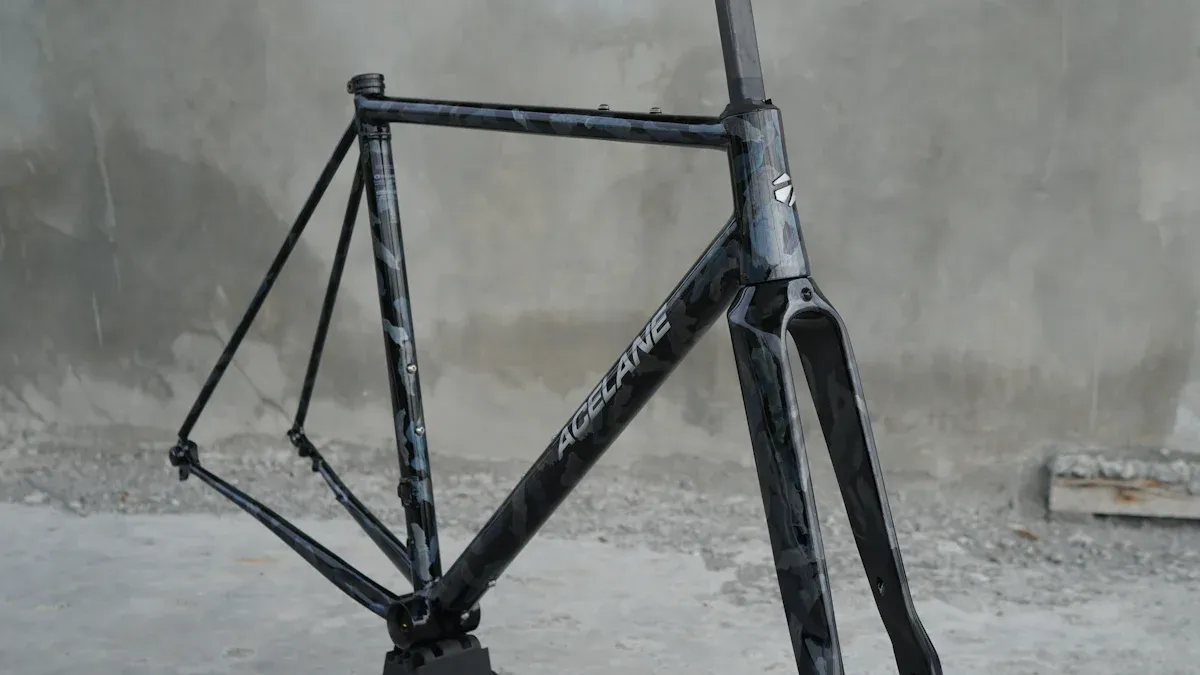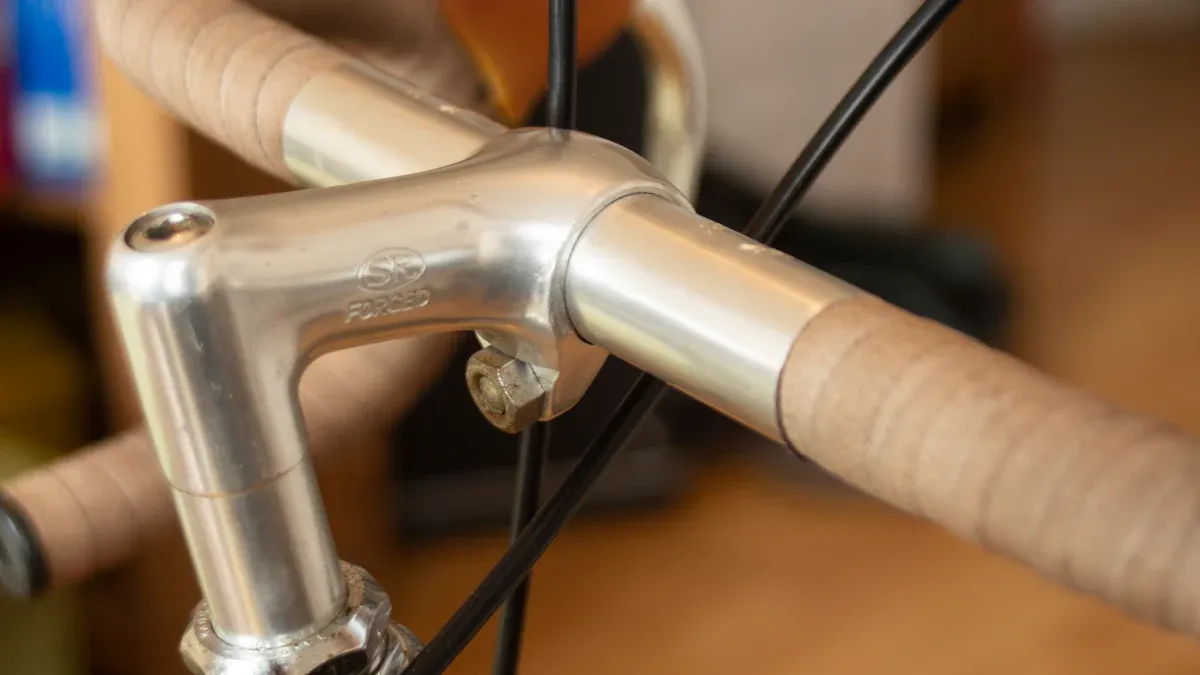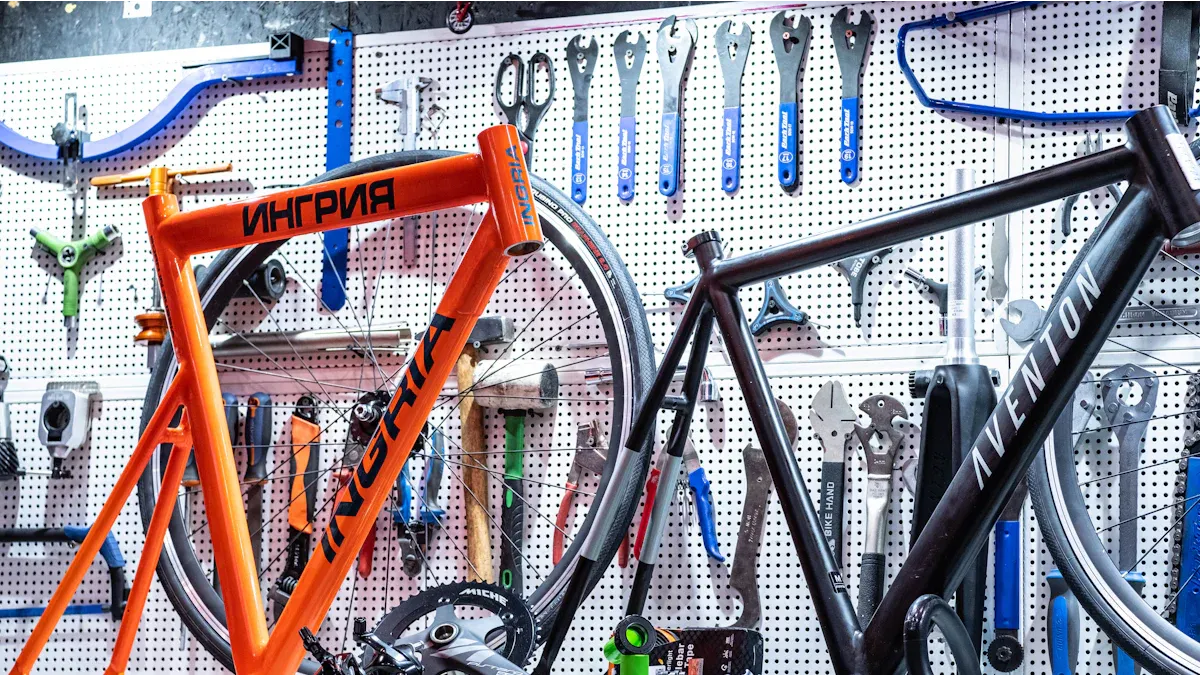
When you look at a lugged frame bike, you see metal sleeves called lugs. These lugs join the tubes at each joint. Builders use brazing to attach the tubes into the lugs. This gives the bike frame a classic look. It also lets them use thinner steel tubes. Many riders pick a lugged frame bike for its smooth ride. They also like its traditional style. Welded bike frames connect tubes directly. This makes the frame stronger and lighter. You might want a lugged frame if you care about looks and comfort. Welded frames are good for people who want a strong and cheaper bike. Knowing these differences helps you choose the best bike for you.
Key Takeaways
Lugged frame bikes use metal sleeves called lugs to join tubes. Brazing connects the tubes and gives a classic look. These bikes also give a smooth ride.
Lugged frames use thinner steel tubes. This makes the bike lighter. It is also easier to fix than welded frames.
Lugged steel frames are easier to repair than aluminum, carbon fiber, or titanium. They also give a more comfortable ride.
Lugged frames cost more because they are handmade. They last longer and are great for touring. People who love classic style also like them.
The best frame depends on what you need. Lugged frames are good for durability and style. Carbon fiber or aluminum frames are better for lightness and speed.
Lugged Frame Bike Construction

What Are Lugs
When you look at a lugged frame bike, you notice special metal sleeves at the joints. These sleeves are called lugs. Lugs connect the tubes of the bike frame together. You slide the ends of the tubes into the lugs, and then the builder joins them using a process called brazing. Lugs help line up the tubes and hold them in place during construction.
Lugs do more than just connect tubes. Many custom bike builders use lugs to add style to a bike. You can find lugs with fancy shapes, cutouts, or even hand-filed details. These artistic touches make hand made bicycles stand out. Some bespoke steel bicycles feature lugs with unique designs, giving each bike a custom look.
How Lugged Frames Are Made
You build a lugged frame by joining steel tubes with lugs. The builder uses silver soldering, also called silver brazing, to attach the tubes inside the lugs. This process uses lower heat than welding. Lower heat keeps the steel strong because it does not change the metal’s structure. In contrast, welding uses high heat, which can weaken the tubing unless the steel is made to handle it.
Note: Lugged construction helps preserve the strength of the steel bike frame. The tubes keep their original properties, so the frame stays strong and lasts longer.
A lugged frame bike often uses thinner-walled steel tubing. Thinner tubes make the bike lighter and give you a smoother ride. The lugs support the joints, so the tubes do not need to be as thick as those in welded frames. This method also makes repairs easier. If a tube gets damaged, a skilled builder can remove it from the lugs and replace it. Many professional frame builders say that a steel bike frame is easy to fix, even in remote places. You can bend, straighten, or even replace tubes on a custom steel bike. This makes lugged frames a top choice for touring and adventure riders.
Here are some key points about lugged frame construction:
Lugs guide the tubes and make the joints strong.
Silver brazing keeps the steel strong by using lower heat.
Lugged frames can last longer than welded frames if built well.
You can repair or replace tubes easily, which is great for long trips.
Materials Used
Most lugged frames use steel tubing. Steel works well with lugs because it can handle the heat from brazing and is easy to shape. You find lugged construction mostly in steel bike frames, especially in custom and bespoke bikes. Some older bikes used lugs with other metals, but steel remains the best choice.
Custom bike builders often pick high-quality steel for lugged frames. This lets them use thinner tubes without losing strength. You get a bike frame that feels lively and smooth on the road. Many hand made bicycles use steel because it is strong, easy to repair, and gives a classic look.
Tip: If you want a bike that lasts and is easy to fix, a lugged steel bike frame is a smart choice.
Bike Frame Comparison

TIG Welded Frames
TIG welded frames are common on new bikes. TIG welding joins tubes right together, not with lugs. The welder melts the tube ends and adds filler metal. This needs careful cuts and a skilled welder. The welds look smooth and modern.
Lugged frame bikes use lugs and brazing. TIG welded frames join tubes without lugs.
TIG welding made building frames faster and cheaper. It lets builders use many tube shapes and sizes.
Schwinn made TIG welded frames popular with lifetime guarantees. This changed how bikes were made.
TIG welded frames can be strong and last a long time. You see them on many performance bikes. The joints look simple but need careful work. TIG welding uses more heat, which can make the joints weaker than lugged frames. Lugged frames keep the steel stronger at the joints because they use less heat.
Note: If you want a modern-looking bike that is easy to make, TIG welded frames are a good pick. Lugged frames look classic and are easier to fix.
Aluminum Frames
Aluminum frames use TIG welding for most joints. Aluminum is much lighter than steel. You notice this when you pick up an aluminum bike. The tubes are bigger and thicker because aluminum is less stiff.
Property | Aluminum Frames | Lugged Steel Frames |
|---|---|---|
Density | ~7.85 g/cc (3 times heavier than aluminum) | |
Young’s Modulus | ~70 GPa (about 1/3 stiffness of steel) | ~200 GPa (3 times stiffer than aluminum) |
Frame Design | Large diameter, thick-walled tubes | Smaller diameter, thinner-walled tubes |
Resulting Weight | About 30% lighter | Heavier due to material density |
Stiffness-to-Weight Ratio | Similar to steel | Similar to aluminum |
Aluminum frames make bikes light and stiff. Designers use bigger tubes to keep the frame strong. This helps in racing and fast riding. Aluminum frames do not last as long as steel. They can crack after years of hard use. You cannot fix them as easily as steel or lugged frames.
Tip: If you want a light bike for speed, aluminum frames are a good choice. They are common in beginner and mid-level bikes.
Carbon Fiber Frames
Carbon fiber frames are made in a different way. Builders layer sheets of carbon fiber in a mold. They use a bladder or foam to press the layers together. Then they heat the frame to make it hard. This lets them control the shape and stiffness of each part.
Frame Material | Common Joint Methods | Description | Impact on Frame Performance |
|---|---|---|---|
Carbon Fiber | Mould layering with bladder or foam | Layers of carbon fiber are shaped and cured in a mold. | High stiffness-to-weight ratio, custom compliance, but joints can be fragile. |
Carbon fiber frames are very light and stiff. Designers can make some parts stiff and others flexible. This gives you a bike with great performance. Carbon fiber frames are the lightest for racing. They also allow cool shapes and fast designs.
But carbon fiber frames are more delicate. They can crack if you crash or drop them. Repairs are hard and cost a lot. The joints can break if damaged. If you want the lightest and fastest bike, carbon fiber is best. If you want a bike that is easy to fix, lugged frames are better.
Titanium Frames
Titanium frames use TIG welding like aluminum and steel. Titanium is light and strong. It does not rust. You get a smooth ride and a frame that lasts many years. Titanium frames cost more because the metal is hard to work with.
Titanium frames are light, comfortable, and strong. Many riders say titanium bikes feel smooth and lively. You do not see lugs on titanium frames because the metal is hard to braze. TIG welding works best for titanium.
Note: If you want a bike frame that lasts a long time and feels great, titanium is a good pick. It costs more, but you get comfort and top performance.
When you look at these bike frame types, you see big differences. Lugged frame bikes use lugs and brazing, which keeps the steel strong and makes repairs easy. TIG welded frames use direct welding for speed and a modern look. Aluminum frames are light and stiff, but do not last as long. Carbon fiber frames are the lightest and fastest, but they break more easily. Titanium frames are smooth, strong, and last a long time, but cost more.
Fatigue resistance is important for performance. Lugged steel frames have better fatigue resistance than TIG welded frames. Brazing uses less heat, so the steel stays strong at the joints. Lugged frames usually break in the tubes, not the joints. Carbon fiber frames are much lighter, but they are more fragile and hard to fix.
You should think about what matters most for your riding. If you want classic style, easy repairs, and long life, lugged frame bikes are a great choice. If you want the lightest and fastest bike, carbon fiber or aluminum frames are best. For a smooth ride and top strength, titanium frames are special.
Lugged Frame Pros & Cons
Ride Quality
When you ride a lugged frame bike, it feels different. Many people say lugged steel frames are smooth and comfy. In the 1980s and 1990s, thin tubing made these bikes absorb bumps well. You feel less shaking and road noise. Cheaper steel frames with thick tubes do not soak up bumps as much. Today, aluminum and carbon fiber frames are better than before. How the frame is built still matters for comfort. Carbon fiber frames can be stiff or bendy, depending on how they are made. Modern aluminum frames use special shapes and metals to balance comfort and strength. All these materials work well, but many riders like the classic feel of lugged frames.
Lugged frames help with vibration and make rides lively.
How the bike rides depends on tubes and design.
Durability & Repair
You want your bike to last and be easy to fix. Lugged frames are tough and can last for years. If a tube breaks, you can swap it out. Fixing welded frames needs special skills and careful work. Lugged frames need their own repair methods, and not every shop can do it. Sometimes you need a custom builder for big fixes. Many touring riders pick lugged frames because you can fix or change tubes. This helps your bike stay in good shape for a long time.
Tip: If you want a bike for long trips or easy repairs, lugged frames are a smart pick.
Aesthetics
Lugged frame bikes look special right away. The lugs have cool shapes and neat designs. Builders make lugs pointy or shaped like arrows. They make the edges thin for a sharp look. Some custom bikes have lugs with metal or stone decorations. The paint is thin so you see all the details. These things make lugged frames look fancy and unique. You get a bike that shows skill and style, not like factory bikes.
Cost
Custom lugged frame bikes cost more money. Making them takes lots of time and skill. Aluminum and carbon fiber frames are cheaper because machines build them fast. New welding methods let companies make strong frames quickly without lugs. Small builders still make lugged frames, but they cost more and take longer to get. Most people buy lighter and cheaper frames for speed and price. That is why lugged frames are not as common now.
Custom lugged frames cost more because they are handmade.
Factory frames use faster and cheaper ways to build.
Note: Lugged frames are rare in new mountain bikes. Most companies want lighter and stronger frames made by welding or molding. Carbon fiber and aluminum do not work with lugs, so new mountain bikes use other ways for better speed and strength.
Frame Type Summary Table
Choosing the right bike frame can feel confusing. You see many options, each with its own strengths. This table helps you compare the most common frame types. Use it to find the best match for your riding style and needs.
Frame Type | Construction Method | Weight | Repairability | Ride Quality | Cost | Typical Use |
|---|---|---|---|---|---|---|
Lugged Steel | Lugs + Brazing | Medium | Easy (replace tubes) | Smooth, classic | High (custom) | Touring, classic road |
TIG Welded Steel | TIG Welding | Medium | Moderate | Smooth, modern | Medium | Road, touring, city |
Aluminum | TIG Welding | Light | Hard (not repairable) | Stiff, responsive | Low-Medium | Racing, fitness, city |
Carbon Fiber | Molded, glued joints | Very Light | Hard (specialist) | Stiff or tuned | High | Racing, performance |
TIG Welding | Light | Moderate | Smooth, lively | Very High | High-end road, touring |
Tip: If you want a bike that lasts and is easy to fix, lugged steel frames stand out. If you want the lightest ride, carbon fiber or aluminum frames work best.
You can use this table to compare what matters most to you:
Do you want easy repairs? Pick lugged steel.
Do you want the lightest bike? Try carbon fiber or aluminum.
Do you care about comfort? Steel and titanium give a smooth ride.
Do you want a classic look? Lugged frames show off style.
🚲 Remember: The best frame for you depends on your riding goals and what you value most in a bike.
Picking the right bike frame is about what matters to you. The table below shows how each frame material fits different needs. Some people like bikes that look classic and are easy to fix. Steel is good for this. If you want a bike that is fast and light, carbon fiber or aluminum might be better. Experts say you should pick a frame that matches how you ride and your body size. Make sure your seat and handlebars are set for comfort and control. The best bike for you is one that fits well, lasts long, and matches your style.
Frame Material | Aesthetics | Repairability | Performance | Rider Preference Influence |
|---|---|---|---|---|
Steel | Classic look, durable | Highly repairable | Comfortable ride, strong | Ideal for durability and classic style |
Aluminum | Modern, lightweight | Less repairable | Lightweight, stiff | Suits riders who want easy handling |
Carbon Fiber | Sleek, high-tech | Low repairability | Very light, smooth | Attracts those who want top performance |
Titanium | Premium, strong | Durable, corrosion-resistant | Light, comfortable | Appeals to riders seeking long-lasting comfort |
Pick a bike frame that fits how you ride.
Change your seat and handlebars for comfort and power.
Ask a bike expert for help to get the best fit.
FAQ
What makes a lugged frame bike different from a welded bike?
You see lugs at the joints on a lugged frame bike. These metal sleeves connect the tubes. Welded bikes join tubes directly without lugs. Lugged construction uses brazing, which keeps the steel strong and gives the bike a classic look.
Can you repair a lugged frame bike easily?
You can repair a lugged frame bike more easily than most welded frames. If a tube gets damaged, a skilled builder can remove and replace it. This makes lugged construction a good choice for long trips or older bikes.
Why do some riders prefer lugged construction?
You might prefer lugged construction for its smooth ride and classic style. Many riders like the detailed lugs and the comfort of thin steel tubes. Lugged frames also offer easy repairs and long-lasting strength.
Are lugged frame bikes good for mountain biking?
You rarely see a lugged frame bike on modern mountain trails. Most mountain bikes use welded or molded frames. These methods make the bikes lighter and stronger for rough terrain.
See Also
Understanding Lugged Bike Frames And Their Manufacturing Process
Key Differences Between Track Bike Frames And Others
Why Mountain Bikes Are Moving Away From Lugged Steel
